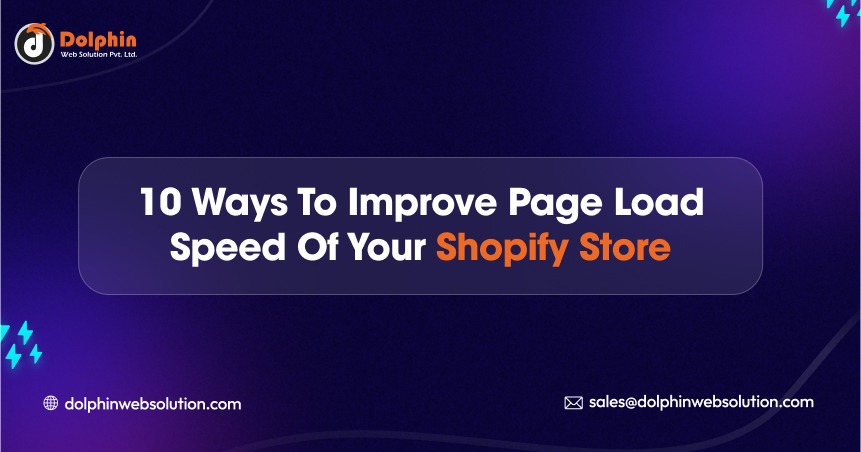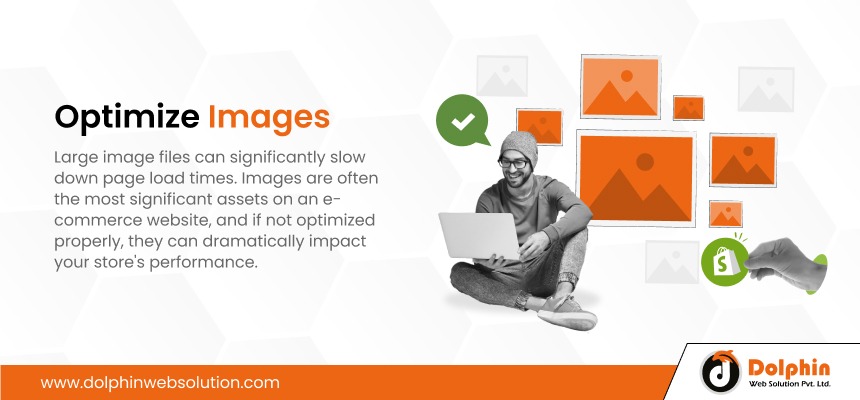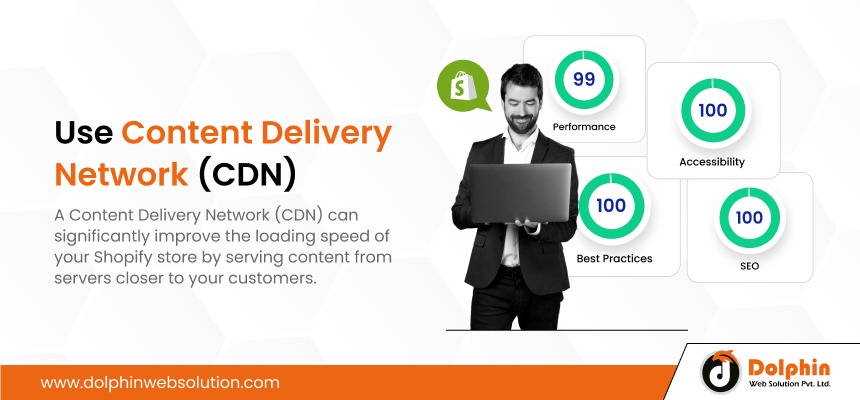10 Ways to Improve Page Load Speed of Your Shopify Store

Table of Contents
Summary :
Improving page load speed for your Shopify store is of peak importance because of adequate visibility and user experience. All the methods to improve this page speed help improve SEO rankings and conversion rates. Various techniques are available to optimize page load speed, and the ten best ways to improve the page load speed of your Shopify store are discussed further in this blog. Read out further to understand better.
In the competitive world of e-commerce, the importance of page load speed must be addressed. Faster loading times enhance user experience and play a crucial role in improving SEO rankings and boosting conversion rates.
Optimizing page load speed is essential for Shopify store owners to stay ahead in the digital marketplace and that’s why Shopify Development service is in high demand nowadays. Multiple strategies can be implemented to improve page load speed, such as selecting a lightweight theme and enabling browser caching.
Top 10 Ways to Speed Up Your Shopify Store Website
As per Google study, If your website takes more than 3 seconds to load, 53% of visitors are likely to abandon it so website speed play crucial role so now let’s check top 10 way to improve shopify website speed.

1. Choose a Lightweight Theme
Selecting a lightweight and well-optimized theme is fundamental to improving page load speed. Shopify offers many themes, but only some are equal in performance. Themes circulating with unnecessary features, large image files, or complex code can significantly slow your store’s loading times.
To ensure your Shopify store loads quickly, it’s essential to choose a theme designed with performance in mind. Some popular fast-loading Shopify themes include Debut, Minimal, and Venture. These themes are known for their clean code, efficient use of resources, and optimized image handling.
When evaluating Shopify themes, consider the following factors to assess their performance:
- Page load times: Test the theme’s demo site or a sample store to measure the overall loading speed.
- Code quality: Look for themes with well-structured, optimized codes that avoid unnecessary bloat.
- Image optimization: Ensure the theme handles image optimization effectively, reducing file sizes without compromising quality.
- Third-party dependencies: Avoid themes that rely heavily on third-party scripts or apps, as they can add additional HTTP requests and slow down your store.
2. Optimize Images

Large image files can significantly slow down page load times. Images are often the most significant assets on an e-commerce website, and if not optimized properly, they can dramatically impact your store’s performance.
To optimize images for your Shopify store, consider the following guidelines:
- Compress image files: Use image compression tools or Shopify apps like Crush. Pics or TinyIMG to reduce the file size of your images without compromising quality.
- Choose the right file format: Based on the image content and desired quality, use the appropriate image format (JPEG, PNG, or WebP).
- Resize images: Ensure your images are not larger than necessary for their intended display size on your website.
- Lazy load images: Implement lazy loading to defer the loading of images until needed, reducing the initial page load time.
- Serve images from a Content Delivery Network (CDN): Using a CDN can improve image loading times by serving them from servers closer to your customers.
3. MinimizeHTTP Requests
Reducing the number of HTTP requests your Shopify store makes is another effective way to speed up page load times. Each HTTP request, whether for an image, a CSS file, or a JavaScript file, adds latency to the page load process. To minimize requests, consider the following techniques:
- Combine CSS and JavaScript files: To reduce the number of requests, combine multiple CSS and JavaScript files into a single file.
- Use image sprites: Combine multiple small images into a single sprite sheet, reducing the number of individual image requests.
- Limit third-party scripts: Carefully evaluate the necessity of third-party scripts and plugins, as they can add additional HTTP requests and slow down your store.
- Optimizefont usage: Limit the number of font styles and subsets used on your Shopify store to reduce font-related requests.
4. Enable Browser Caching
Browser caching is a crucial technique for improving page load speed, especially for repeat visitors. When a user visits your Shopify store, the browser can cache specific resources, such as images, CSS files, and JavaScript files, to reduce the need to download them again on subsequent visits.
To enable and optimize browser caching, consider the following steps:
- UtilizeShopify’s default cache settings: Shopify automatically caches certain assets, such as theme files and product images, to improve loading times.
- Extend cache expiration times: Increase the cache expiration times for static assets like CSS, JavaScript, and images to reduce the need for re-downloading.
- Implement a Shopify app for advanced caching: Consider using a Shopify app like Boost Cache or Cache Enabler to optimize your store’s caching settings further.
5. Compress CSS and JavaScript
Compressing your CSS and JavaScript files can also increase page load times. By minifying these files, you can reduce their file size and the amount of data that needs to be transferred to the user’s browser.
There are several ways to compress CSS and JavaScript in your Shopify store:
- Use Shopify’s built-in asset optimization: Shopify automatically minifies and compresses your theme’s CSS and JavaScript files.
- Leverage a Shopify app for compression: Apps like Crush. Pics or Crush.js can automate the minifying and compressing of your CSS and JavaScript files.
- Manually minify files: You can use online tools or command-line tools to manually minify your CSS and JavaScript files before uploading them to your Shopify store.
6. Reduce Redirects
Redirects can add extra HTTP requests and slow down your Shopify store’s page load times. While some redirects may be necessary, it is essential to minimize their use and ensure they are implemented judiciously.
To reduce redirects in your Shopify store, consider the following strategies:
- Avoid unnecessary redirects: Carefully review your store’s URLs and eliminate any redirects that are not essential.
- OptimizeURL structure: Ensure your Shopify store’s URL structure is clean and intuitive, reducing the need for redirects.
- Use Shopify’s built-in redirect management: Shopify provides a built-in redirect management system that allows you to create, manage, and monitor redirects easily.
- Leverage Shopify apps for redirect optimization: Apps like Redirect Manager or Redirect Pro can help you identify and manage redirects more effectively.
7. Optimize Fonts

Web fonts can significantly impact your Shopify store’s page load speed. Poorly optimized font usage can delay text rendering and a sluggish user experience. To optimize fonts for your Shopify store, consider the following tips:
- Limit font styles and subsets: Use only the necessary font styles and character subsets to reduce the file size of your web fonts.
- Leverage font-display property: Set the font-display property in your CSS to control how fonts are loaded and displayed, reducing the impact on the initial page load.
- Preload critical fonts: Use the tag to preload the most critical fonts, ensuring they are available soon.
8. Enable Lazy Loading
Lazy loading is a technique that defers the loading of non-essential content until it’s needed, reducing the initial page load time. This approach can be particularly beneficial for e-commerce websites, where images, videos, and other media-rich content can significantly impact loading speeds
To implement lazy loading in your Shopify store, consider the following options:
- Use Shopify’s built-in lazy loading: Shopify’s theme editor provides an option to enable lazy loading for images, which can quickly and easily improve performance.
- Leverage Shopify apps for lazy loading: Apps like Lazy Load, Lazy Load for Shopify, or Lazy Load by Astra can automate the process of implementing lazy loading for various content types.
- Manually implement lazy loading: You can also manually implement lazy loading using JavaScript or a library like Intersection Observer API, providing more fine-grained control over the lazy loading process.
9. Use Content Delivery Network (CDN)

A Content Delivery Network (CDN) can significantly improve the loading speed of your Shopify store by serving content from servers closer to your customers. CDNs cache static assets, such as images, CSS, and JavaScript files, and deliver them from the nearest server, reducing the distance and latency between the user and the content.
When it comes to Shopify, several popular CDN services are compatible with the platform:
- Cloudflare: Cloudflare is a widely used CDN that integrates seamlessly with Shopify, offering features like automatic image optimization and advanced caching.
- Amazon CloudFront: Amazon’s CDN service, CloudFront, can be configured to work with Shopify, providing global content delivery and improved performance.
- Fastly: Fastly is another CDN option known for its fast and reliable content delivery, making it suitable for Shopify stores.
10. Regularly Monitor Performance With Google PageSpeed Insights Tool

Regularly monitoring the performance of your Shopify store is crucial to maintaining and improving its loading speed. There are several tools and metrics you can use to track your store’s performance, including:
- Google PageSpeed Insights: This free tool from Google provides detailed insights into the performance of your Shopify store, including recommendations for optimization.
- GTmetrix: GTmetrix is another popular performance testing tool that analyses your store’s loading speed and provides actionable recommendations.
- Shopify’s built-in analytics: Shopify’s analytics dashboard includes performance metrics, such as page load times, that you can use to monitor your store’s performance.
Conclusion: Hire Shopify Developers
Prioritizing page load speed is paramount for a successful Shopify store. By implementing the suggested techniques, such as choosing a lightweight theme, optimizing images, minimizing HTTP requests, enabling browser caching, compressing CSS and JavaScript, reducing redirects, optimizing fonts, enabling lazy loading, and leveraging a CDN, you can enhance user experience, boost conversions, and stay ahead in the competitive e-commerce landscape.
Consider hiring a Shopify development expert to ensure your Shopify store is optimized for maximum performance. These professionals can provide tailored solutions, leverage their expertise, and help you navigate the various optimization strategies to achieve the best results for your online business.

Hello!
Click one of our contacts below to chat on WhatsApp


